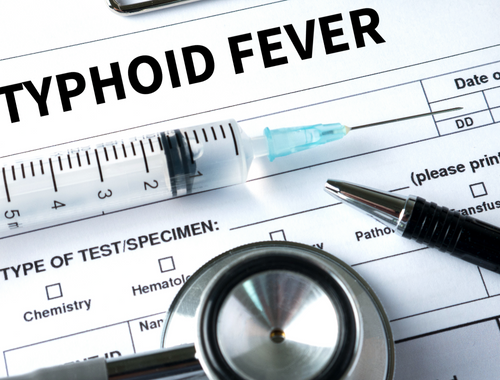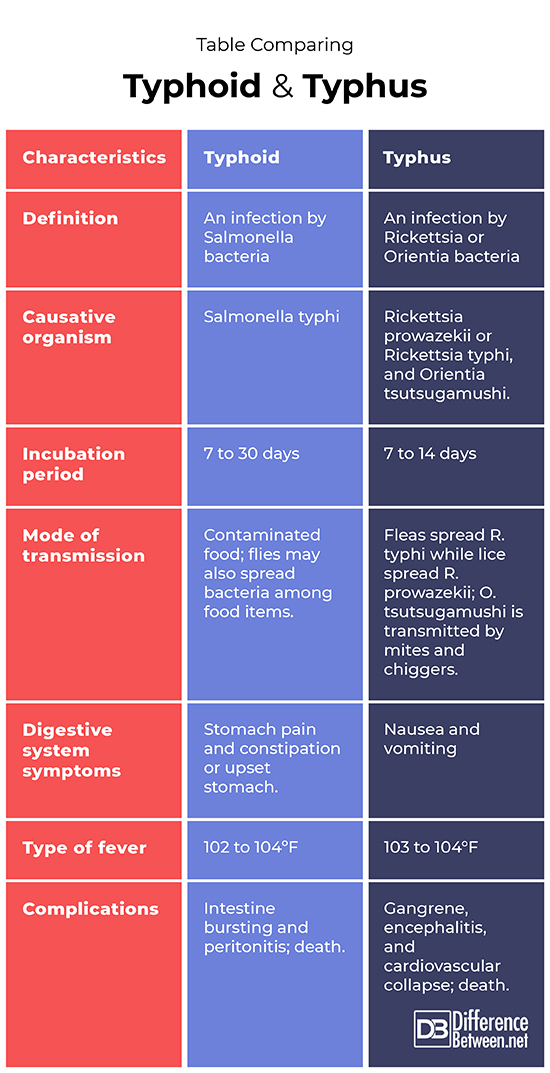Difference Between Typhoid and Typhus
Typhoid is a bacterial infection due to the bacterium Salmonella typhi. Typhus is a bacterial infection that is due to infection with either Rickettsia or Orientia bacteria.

What is Typhoid?
Definition:
Typhoid is an illness caused by bacteria known as Salmonella typhi.
Causative pathogen:
Typhoid is caused by bacteria called Salmonella typhi.
Diagnosis:
Typhoid can be diagnosed using blood samples and testing for the presence of the bacteria. Urine and stool samples can also be tested for S. typhi. The bacteria can be cultured in the laboratory from these specimens and then identified using microscopy.
Symptoms:
The symptoms of typhoid include digestive signs such as stomach pain, diarrhea, or constipation. The person also has a high fever that stays high for at least a week. A skin rash also often develops that consists of red spots that occur on the chest and belly. Anemia is also a common finding along with clotting problems in the blood.
Complications:
Possible complications of typhoid include the intestine bursting causing peritonitis. This can cause sepsis and death.
Treatment:
Treatment for typhoid is by using antibiotics, especially ceftriaxone and ciprofloxacin.

What is Typhus?
Definition:
Typhus is a bacterial infection that is due to infection by Rickettsia and Orientia organisms.
Causative pathogen:
There are three types of bacteria that cause typhus: Rickettsia typhi, R. prowazekii, and Orientia tsutsugamushi.
Diagnosis:
Diagnosis of typhus can be made with a skin biopsy in which the bacteria are detected. Other tests like PCR and antibody testing are also helpful in showing the presence of the bacterial nucleic acid.
Symptoms:
Symptoms of typhus include headache, high fever, chills, and painful muscles. Nausea and vomiting, and a skin rash are also signs of typhus. Another notable symptom of typhus is the development of a skin rash. This rash begins after about 6 days and it consists of little red papules that spread from the belly to the chest and extremities. People with typhus may have low blood pressure and an enlarged spleen.
Complications:
Typhus can worsen with the rash leading to gangrene. There can also be involvement of the brain leading to encephalitis, and the cardiovascular system may collapse. Sometimes people with typhus come down with pneumonia as well as further complications.
Treatment:
Treatment of typhus is with chloramphenicol and penicillin.
Difference between Typhoid and Typhus?
Definition
Typhoid is an infection of S. typhi bacteria. Typhus is an infection with either Rickettsia or Orientia bacteria.
Causative organism
The causative organism of typhoid is Salmonella typhi. The causative organisms for typhus include Rickettsia prowazekii, Rickettsia typhi, and Orientia tsutsugamushi.
Incubation period
The incubation period of typhoid is 7 to 30 days. The incubation period of typhus is 7 to 14 days.
Mode of transmission
Typhoid is transmitted when people eat food contaminated with the bacteria; flies can also carry bacteria that they pick up from food; these flies then can vector the bacteria to other food items. Typhus is transmitted by one of the following arthropods: fleas, mites, chiggers, and lice. The particular host involved in typhus transmission varies by bacterial species.
Digestive system symptoms
Digestive system symptoms evident in people with typhoid fever include pain in the belly, constipation, and diarrhea. Digestive system signs in people with typhus include vomiting and nausea.
Type of fever
Patients with typhoid present with a body temperature of 102to 104oF. Patients with typhus have a temperature of 103 to 104°F.
Complications
The complications of typhoid include intestinal rupture and peritonitis. The complications of typhus include gangrene, cardiovascular collapse, and encephalitis.
Table comparing Typhoid and Typhus

Summary of Typhoid Vs. Typhus symptoms
- Typhoid and typhus are both infections caused by bacteria.
- Typhoid is transmitted by eating contaminated food.
- Typhus is transmitted by being bitten by an insect or arthropod that is carrying the pathogenic bacteria.
- Both typhoid and typhus are less common today due to improved hygiene measures and the development and use of antibiotics.
FAQ
What is typhus called today?
Today the infection is still known as typhus or typhus fever.
What is the difference between typhoid and fever?
Typhoid is a particular type of infection that causes a fever. The term fever simply refers to an elevated body temperature. Many illnesses besides typhus cause a high fever so fever alone does not indicate what illness a person has.
What is the symptom of typhus?
Symptoms of typhus include a sore head, fever, muscle aches, and nausea. A rash develops later on the skin. This rash often begins on the belly and spreads to include the arms and legs and chest.
What is the difference between typhoid and paratyphoid?
Typhoid is caused by Salmonella typhi while paratyphoid is caused by S. paratyphi, a different bacterium.
What are the 3 types of typhus?
The three types of typhus are murine typhus, epidemic typhus, and scrub typhus. These three types of typhus are caused by different bacteria and carried by different host arthropods such as mites, fleas, and lice.
Can you survive typhus?
Yes, many people survive typhus since there are antibiotics available today that can kill the bacteria causing the infection. There is, however, a high rate of death in older people who are not treated with antibiotics.
- Difference Between Rumination and Regurgitation - June 13, 2024
- Difference Between Pyelectasis and Hydronephrosis - June 4, 2024
- Difference Between Cellulitis and Erysipelas - June 1, 2024
Search DifferenceBetween.net :
Leave a Response
References :
[0]Bush, Larry M. and Maria T. Vazquez-Pertejo. “Typhoid fever”. Merckmanuals. Merck & Co., 2022, https://www.msdmanuals.com/professional/infectious-diseases/gram-negative-bacilli/typhoid-fever
[1]Mahajan, S. K. "Scrub typhus." JAPI 53.955 (2005): 269.
[2]Petri Jr., William A. “Epidemic typhus (European Typhus; Classic Typhus; Louse-Borne Typhus; Jail Fever) ”. Merckmanuals. Merck & Co., 2022, https://www.msdmanuals.com/professional/infectious-diseases/rickettsiae-and-related-organisms/epidemic-typhus
